The flame to learn still burns
Girlish voices raised in joyous song, ‘Brown girl in the ring’ they sing with gusto, while across the grounds there is no ‘ring’ but a sole punching bag which students take turns to beat up.
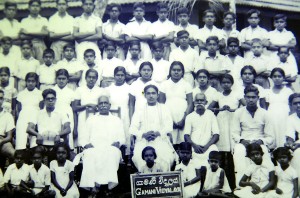
The children of ‘Parana Gamani’ with Minister Kannangara and teacher Sooriyaarachchi
The girls are preparing for an island-wide singing competition while the young boxers have already proven their mettle, even with very limited resources.
They are not the only winners – seven who sat the Advanced Level examination in 2011 are already in university.
We are at the Gamani Madhya Maha Vidyalaya (MMV) very close to Ingiriya town, on the A8 or the Panadura-Ratnapura Road. Here amidst numerous challenges, they are set on winning, like a ‘teacher’ of yore battled to keep the flame of learning burning.
If not for S.P. Sooriyaarachchi clad in a spotless white sarong and white banian who left his comfortable home in Labugama, in Horana’s
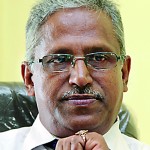
Principal Chandrapala
Haltota area, to live under difficult conditions, there would be no Gamani MMV today.
Set amidst five acres, but needing more land to establish a proper playground, Gamani MMV caters to the educational needs of 1,684 children who have not been able to secure the necessary marks at the Grade 5 scholarship examination to attend ‘better and bigger’ schools. These children are also from socially and economically challenged backgrounds, according to Principal D.D. Chandrapala.
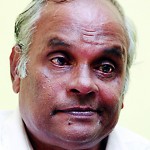
Retired Bank Officer Jayakody
While classes are from Grades 6 to the Advanced Level, a majority of the parents of these children eke out a living each day by mining sand, tapping rubber milk or plucking tea leaves. The others work in garment factories in Horana.
The beginnings of Gamani MMV which is now a 1AB (having all three streams of science, commerce and arts at the ALs) school with 85 teachers, have been humble, very humble. With a Baptist English school being opened in the area and parents fearful that children would be doled out not only English but also religion, influential people in the village had seen a necessity for English. Two youth who had ventured beyond the boundaries of the village and come back with a knowledge of English had been mobilised to begin classes in a little cadjan-thatched hut on a corner of a property.

S.P. Sooriyaarachchi
When the time came for the two young men, Abeypala Jayakody and Gallage G.D. Edwin, to move on, after getting jobs with the government, fearful of the English teaching exercise coming to naught, Don Nomis Jayakody who was the initiator had begun a desperate search. It ended with Sooriyaarachchi, another young man who was willing to do the task.
The chequered history of Gamani MMV over the past 75 years unravels with the help of Principal Chandrapala and retired Bank Officer Tissa Jayakody.
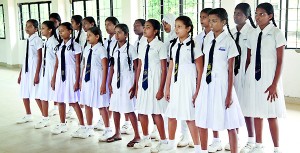
‘Brown girl in the ring’ : Present day students singing to their hearts’ content. Pix by M.A. Pushpa Kumara
Whereas the earlier two were from the village itself, Sooriyaarachchi was from Labugama. He came, he settled down and began his work in the cadjan-thatched maduwa, with nary a thought of money.
The villagers gave him food on and off, but his commitment was such that he would go home to his father in Labugama, get a little money from him and also bring back his dry rations such as rice and coconuts from his parents’ fields.
He would return late at night, carrying on his head and shoulders whatever he was able to carry and singing pel kavi to ward off the loneliness of travelling alone through hardly-inhabited areas.
As the number of children drawn to the study of English increased, the classes moved to an ambalama originally set up to cater to the needs of tired and weary devotees on their way to the holy mountain of Sri Pada. When passing through the area they would make such a racket in the middle of the night that the ambalama had been built for them to lay down their weary heads before resuming their journey on foot.
Expanding the English classes held in the night to a school with student numbers on the increase, once again space became a problem. It was then that the generosity of Rambukkanage Appu Singho became the catalyst for the ‘Parana Gamani’ to come into being. Giving part of his land for the setting up of the school, all the teaching had been done in a hall, built with kabok cut from the land itself.
As Gamani MMV was in the midst of preparations to celebrate its 75th year with a bust of Sooriyaarachchi being sculpted in the school and a book on his life and times being launched on Tuesday, 83-year-old R. Chandradasa whose father gave the land for the ‘Parana Gamani’ speaks about the kindness and gentleness of Sooriyaarachchi.
“Eyata sera-bera thibbe ne,” he recalls, adding that Sooriyaraarachchi never reprimanded students.
Space for expansion was not the only challenge faced by young Sooriyaarachchi, for he was “going upstream, against the current”, according to his family.
The malicious kele pattara that came up overnight Sooriyaarachchi ignored, soldiering on with his mission, although he was crossing swords with the rich and the powerful in the area who saw no reason to educate the children of their labourers while they themselves sent their offspring to good schools in the cities.
There was also no support forthcoming from the education authorities. Seeing the English teaching exercise blossom, when he pleaded with the ‘Education Department, Ceylon’ way back in 1938 for recognition of KL/Ingiriya Gamani Boys’ English School, the polite but firm answer had been that the Director of Education has the “honour” to inform him that the school is considered “unnecessary”.
The Director had also pointed out in a letter dated 20th January 1938 that “the building in which the school is at present housed is unsatisfactory. It is also reported that you do not possess sufficient means to be the Manager of an English School”.
Internal and external pressures, however, did not deter Sooriyaarachchi, who persisted in his task, until finally he was able to convince the government on the necessity to give its stamp of approval to the school in 1946.
Even though Sooriyaarachchi himself had to leave the school after the government takeover as he possessed no “certificates” to get a teaching appointment, he has left a vibrant legacy, along with an old but cherished black-and-white photograph taken the day then Education Minister C.W.W. Kannangara visited the school to sign the takeover documents.
Holding close to his heart the words of statesman Sir D.B. Jayathilake who had said “if you want to see your child being well educated, ensure your neighbour’s child too is educated”, Sooriyaarachchi went back to his village the same way he had come to Ingiriya, with nothing, to set up another little school on his own property in Labugama, which is also thriving as Vijitha Maha Vidyalaya.
| Achieving amidst hurdles
The achievements, even in the resource-poor setting, of Gamani MMV are many: Fourteen-year-old P.A. Rukmal Prasanna and K.V. Lasindu Eranda have won many ‘golds’ for their boxing prowess in three all-island tournaments this year, while Mihiri Mahesha Kumudini, 19, had won the gold at the Junior National Boxing Meet in 2012. R. Piyumi Priyanthika won colours at the All-Island Throwball Championships 2012, while the school team became runners-up. Of the seven (three girls and four boys) who have gained entry to the university from the 2011 ALs, Chanaka Siriwardena had come first in the Kalutara district in the commerce stream. |
||
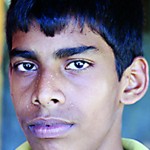 Lasindu |
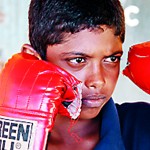 Rukmal |
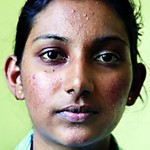 Udayanthi Munasinghe in campus now |


